Correlative Aspects between Heart Rate, Lactic Acid and Exercise Intensity in the Training of Water Polo Players – Junior III
Abstract
Keywords: Water polo, heart rate, lactic acid, exercise intensity
Introduction
In water polo game, acyclic movements are prevailing, and the metabolic characteristic of effort is
represented by strength endurance with anaerobic penetrations (Marinescu, Frăţilă, & Bălan, 2004: 7).
The specificity of effort is given by the muscular characteristic, the metabolic one, and by
characteristics related to tempo and rhythm (Marinescu, 2003: 126). Exercise capacity does not sum up
the functional capacities of all organs and systems of the human body, being “limited by those organs
which, after reaching maximal functional capacity, hinder continuation of the exercise, although other
organs and systems still allow it” (Dragnea, quoted by Cordun, 2011: 52).
Training monitoring through cardiovascular functional tests (heart rate) at rest and during specific
effort or in the recovery period, correlated to biochemical testing of effort/ its hardness (lactic acid) and
intensity, allows us to assess the functional and metabolic harmony/disharmony of athletes’ body,
depending on the dominant energy systems in water polo game. Specialty literature provides few data
about the metabolic cost of exercise in children and juniors - water polo, compared to seniors. Platanou
and Geladas (2006) report lactic acid values comprised between 2 and 12 mmol, with an average of 3.9
mmol in a friendly match played by the senior representative team of Greece.
As regards the directly usable markers for controlling exercise intensity, the anaerobic threshold still
remains a fashionable training concept (Brunet-Guejd et al., 2006: 11). Given that the anaerobic
threshold is qualitatively inferior to maximal oxygen consumption (VO2) zone, in our research, through the tested training means (higher aerobic zone - VO2), we want to prove the correlation between an external effort parameter (intensity) and two internal parameters (heart rate and lactic acid).
Materials and methods
2.1. Hypothesis
Knowing the heart rate, lactic acid and work intensity during training sessions allows water polo
coaches to efficiently manage the effort in order to achieve the objectives established.
2.2. Research methods
This paper represents an ascertaining pedagogical experiment, and the research methods used were:
testing method, graphical method, statistical and mathematical method with the following statistical
parameters: central tendency indicator (arithmetic mean), percentages (Popa, 2008).
2.3. Period, location and subjects of the research
The experiment tested 4 water polo players registered at three different clubs from Bucharest and
competing in the National Championship. The athletes are born in 2002 and are basic players of the
club teams to which they belong. Testing was conducted on 15 December 2014 at the “Miramar”
Swimming Pool located in Bucharest, sector 2, 6-8 Chisinau Blvd.
2.4. Description of the monitored training
We have chosen a training means for the higher aerobic metabolic zone (enduranceVO2max), because preparation using this type of exercise also provides direct and indirect indications on improvements of the anaerobic-type exercise (lactate tolerance). We mention that, for acyclic games and sports, higher aerobic capacity improves through mixed training sessions: VO2max at the central level and AA (anaerobic alactacid) at the peripheral level (Brunet-Guejd et al., 2006: 11).
Preparing the body to effort (warm-up), with a 30-second break between exercises, I: 50-60%.
4 x 33m leg crawl with a float device, break: 10 sec.; 4 x 33m gliding crawl, break: 10 sec.; 4 x 33m leg crawl with butterfly arm strokes, break: 10 sec.
Fundamental part aims to train the higher aerobiosis zone (VO2max), I: 90%.
3 x (4 x 100m crawl) with a 10-second break between repetitions and 5 minutes between series. Cooling down after exercise, I: 50-60%.
6 x 33m double backstroke, break: 20 sec.
2.5. Device used
Heart rate (HR) monitoring during training was achieved using HOSAND GT. AQUA telemetry
system (Fig. 1). Hosand transmitter receives data about the athlete’s heart rate from the standard chest
strap belt and sends them in real time to the receiver and a PC, where the software displays the heart
rate, stores and analyses the data. Athletes wear a specially designed vest, which contains a belt and a
Hosand transmitter. The vest is hydrodynamic, and the data caught by the transmitter are transmitted
even while the athlete is under water or swimming the backstroke, to a PC unit through a radio
frequency. Hosand transmitter is waterproof and is housed in a pouch, on the back of the vest, under
the Hosand label.
Blood lactate at the end of training was determined using the LACTATE PRO analyser, through the
electrochemical measurement method (dry chemistry method) (Fig. 2).
Work intensity was established calculating the time recorded for every 100m covered and in relation
with the time achieved for the same distance in an official competition.
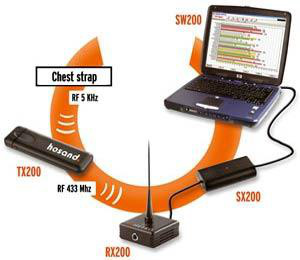
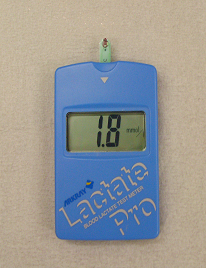
Results
To better understand the effort dynamics interpreted through the internal parameter (heart rate), we
present one single suggestive graph, with its evolution during training, for the athlete L.M. (Fig. 3). He
starts training at a HR value of 94 bpm. After the first warm-up exercise, HR reaches 118 bpm, after
the second exercise, HR reaches 145 bpm, and at the end of the first part (warm-up), HR attains 180
bpm.
After a 10-minute break, the athlete starts the fundamental part of training, the first series, at a HR
of 100 bpm, which reaches 185 bpm after the first repetition and returns, in the 10-second break, to 179
bpm; after the second repetition, HR reaches 189 bpm and returns to 179 bpm; after the third repetition,
HR reaches 191 bpm and returns to 185 bpm; after the fourth repetition, HR reaches 192 bpm, and in
the first minute of the 5-minute break between series, HR attains 120 bpm –
up pulse.
In the second series, the athlete starts from a HR value of 120 bpm and reaches 189 bpm after the
first repetition, and in the 10-second break, HR returns to 182 bpm; after the second repetition, HR
reaches 191 bpm and returns to 183 bpm; after the third repetition, HR reaches 191 bpm and returns to
184 bpm; after the fourth repetition, HR reaches 197 bpm, and in the first minute of the 5-minute break
between series, HR attains 124 bpm –
In the third series, the athlete starts from a HR value of 120 bpm and reaches 186 bpm after the first
repetition, and in the 10-second break, HR returns to 181 bpm; after the second repetition, HR reaches
189 bpm and returns to 183 bpm; after the third repetition, HR reaches 193 bpm and returns to 186
bpm; after the fourth repetition, HR reaches 192 bpm, and in the first minute after effort, HR is equal to
120 bpm – corresponding to a warm-up pulse.
Cooling down after exercise uses an effort comprised between 120 and 140 bpm.

77
Figure 4 shows the times recorded by the 4 athletes at each repetition of 100m swim within the 3
series. Results recorded by the athletes G.S., L.M. and P.E. highlight the linear evolution, the consistent
intensity for the parameters required during repetitions (a primordial methodical prerequisite to train
VO2max) and the compliance with the ideal basic rule in approaching the specific tempo and rhythm. The evolution of times on every 100m swim within the series and between them indicates that the
athlete V.I. has failed in respecting the tempo and rhythm imposed by the training methods for the
metabolic VO2max zone. In the 3 series, only the first repetition complies with the times imposed; all the other repetitions in the 3 series are swum at an increasingly smaller intensity, which represents an
incorrect approach to the race schedule.
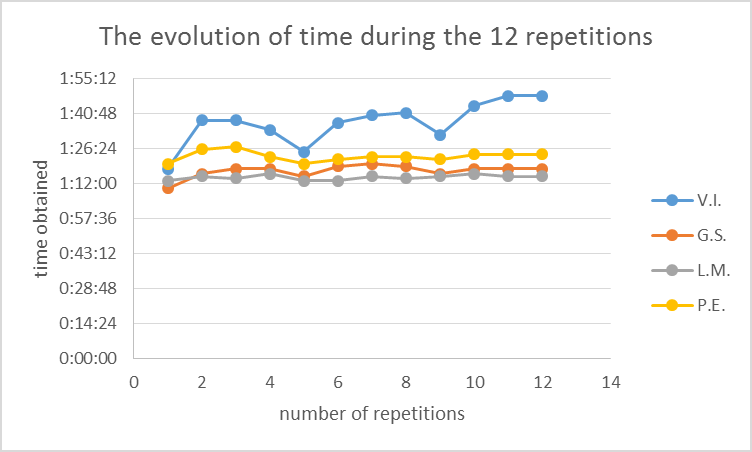
Figure 5 shows the heart rate values for the 4 athletes at each repetition of 100m swim within the 3
series. Analysing the graphs, we notice that the athletes have recorded heart rates imposed by both the
preparation in VO2max zone and the anaerobic threshold, in relation to the theoretical maximum heart rate (Spiro, 1977).
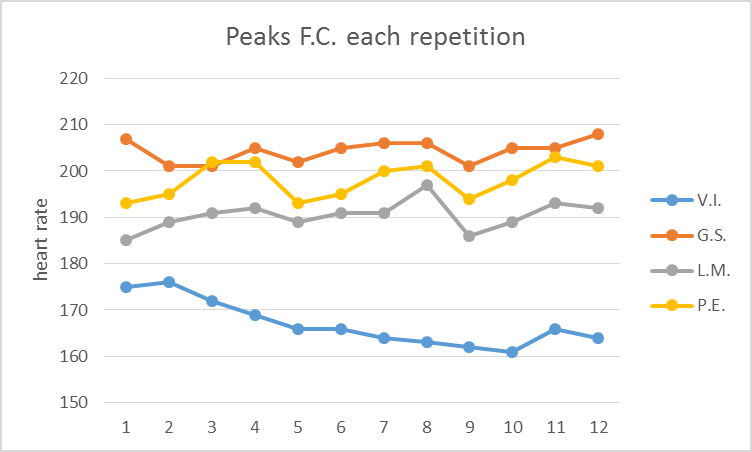
Comparing the heart rates recorded during exercise by the athlete V.I., it can be noticed their
correlation with the times recorded during repetitions (Fig. 4), which supports our arguments
aforementioned about this athlete: he works at anaerobic threshold intensities (average HR = 167 bpm),
without observing the training tasks. The athletes G.S., L.M. and P.E. frame within the heart rate
parameter related to the theoretical maximum heart rate in VO2max zone.
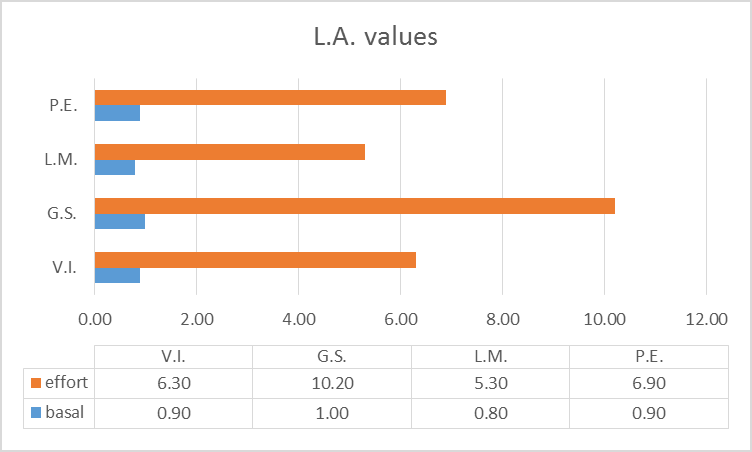
In Figure 6, it can be seen that the evolution of lactic acid accumulation during exercise respects the
functional condition of higher aerobiosis zone (4 to 12 mmol for the anaerobic threshold and VO2max zones). The tested athletes start exercising from normal values of basal metabolism (< 2mmol).
Analysing the values of parameters recorded in Table 1, we can assert that there are positive
correlations between the three parameters, according to the requirements of higher aerobic metabolic
zone, in all 4 athletes. We can exemplify that the athlete L.M. responds to exercise requirements
through a very good functional harmony: he works at a VO2max intensity of 94%, an average heart rate of 190 bpm, and lactic acid has low values - 5.3 mmol. The lactic acid value of 5.3 mmol, at an
exercise intensity of 94%, suggests that the athlete has an individual aerobic threshold higher than 4
mmol (standard). Knowing that the anaerobic threshold relates to VO2max percentages, it can be concluded that the athlete is able to perform with easiness qualitatively higher VO2max exercises for a longer period of time (about 30 min.). By extension, performing specific VO2max exercises, the athlete/athletes will accumulate more lactic acid and will improve thus the lactate tolerance zone.
Discussions and conclusions
Analysing the correlation between internal and external effort parameters needed to reach VO2max, we can conclude that the athletes have worked correctly, specifically to the higher aerobiosis zone.
It is possible to express intensity in percentages of the theoretical maximum heart rate, as a
prerequisite to reach maximal oxygen consumption.
One cannot make a correct prediction of/ connection between the value of maximal heart rate
reached and the performance level.
The decrease in maximal heart rate for one of the athletes during endurance training might be due to
the heart output adaptation, increasing the systolic ejection volume.
Knowing the heart rate, lactic acid and work intensity during training sessions allows water polo
coaches to efficiently manage the effort in order to achieve the objectives established –
is confirmed.
Apparently paradoxically, the use of lactic acid output in our research is correlated to higher aerobic
processes, and the test results validate the suitability of the means proposed/chosen for the experiment,
in a close relation with the effort specificity, the research topic and the hypothesis appropriateness.
Acknowledgements
This paper is achieved and published under the aegis of the National University of Physical
Education and Sports of Bucharest, as a partner of the programme co-funded by the European Social
Fund within the Operational Sectoral Programme for Human Resources Development 2007-2013
through the project Pluri- and interdisciplinarity in doctoral and post-doctoral programmes Project
Code: POSDRU/159/1.5/S/ 141086, its main beneficiary being the Research Institute for Quality of
Life, Romanian Academy.
We thank the interdisciplinary specialist team who helped us achieve the experiment: “Aqua Team”
Sports Club, INCS Bucharest, Romanian Water Polo Federation.
References
Brunet-Guejd, E., Brunet, B., Girardier, J., & Moyen, B. (2006). Medicine du sport. Paris: Masson.
Cordun, M. (2011). Bioenergetică şi ergometrie în sport. Bucureşti: CD Press.
Marinescu, Gh. (2003). Nataţie - efort şi antrenament. Bucureşti: Bren.
Marinescu, Gh., Frăţilă, C., & Bălan V. (2004). Polo pe apă. Bucureşti: Bren.
Platanou, T., & Geladas, N. (2006). The influence of game duration and playing position on intensity of exercise during match-play in elite water polo players. J Sports Sci, 24(11), 1173-1181.
Popa, M. (2008). Statistică pentru psihologie - Teorie şi aplicaţii în SPSS. Iași: Polirom.
Spiro, S. (1977). Exercise testing in clinical medicine. British Journal of Diseases of the Chest, 71(3), 145-172.
Copyright information

This work is licensed under a Creative Commons Attribution-NonCommercial-NoDerivatives 4.0 International License.
About this article
Publication Date
10 June 2016
Article Doi
eBook ISBN
978-1-80296-010-5
Publisher
Future Academy
Volume
11
Print ISBN (optional)
-
Edition Number
1st Edition
Pages
1-509
Subjects
Sports, sport science, physical education
Cite this article as:
Marinescu, G., Ticala, L. D., Mujea, A. M., & Bidiugan, S. N. (2016). Correlative Aspects between Heart Rate, Lactic Acid and Exercise Intensity in the Training of Water Polo Players – Junior III. In V. Grigore, M. Stanescu, & M. Paunescu (Eds.), Physical Education, Sport and Kinetotherapy - ICPESK 2015, vol 11. European Proceedings of Social and Behavioural Sciences (pp. 74-81). Future Academy. https://doi.org/10.15405/epsbs.2016.06.11

